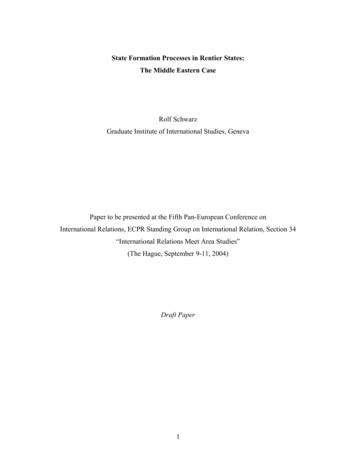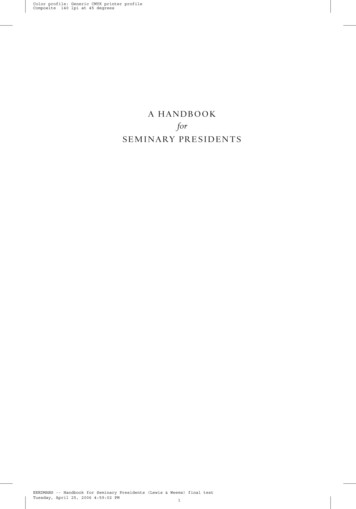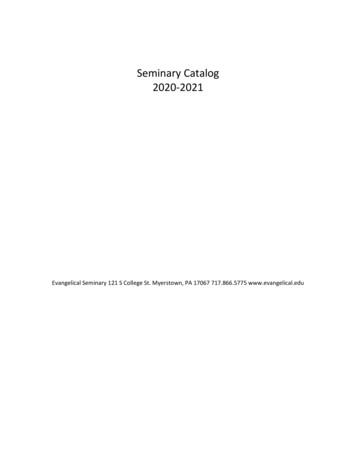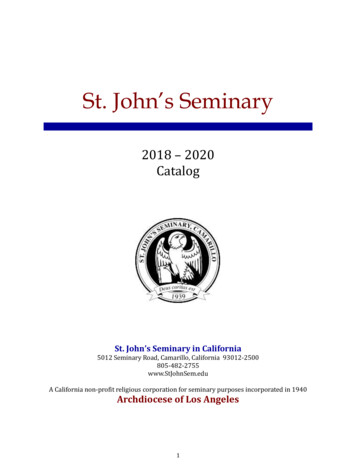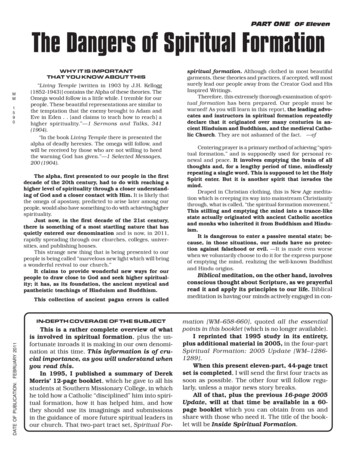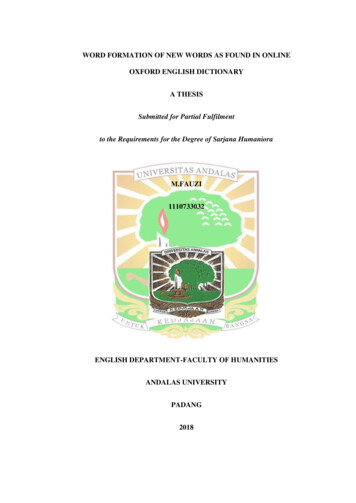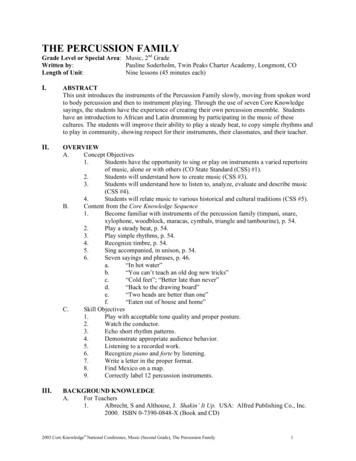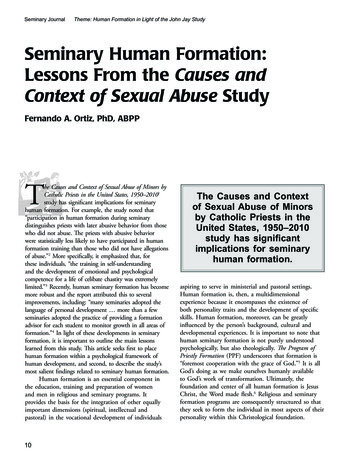
Transcription
Seminary JournalTheme: Human Formation in Light of the John Jay StudySeminary Human Formation:Lessons From the Causes andContext of Sexual Abuse StudyFernando A. Ortiz, PhD, ABPPThe Causes and Context of Sexual Abuse of Minors byCatholic Priests in the United States, 1950–20101study has significant implications for seminaryhuman formation. For example, the study noted that“participation in human formation during seminarydistinguishes priests with later abusive behavior from thosewho did not abuse. The priests with abusive behaviorwere statistically less likely to have participated in humanformation training than those who did not have allegationsof abuse.”2 More specifically, it emphasized that, forthese individuals, “the training in self-understandingand the development of emotional and psychologicalcompetence for a life of celibate chastity was extremelylimited.”3 Recently, human seminary formation has becomemore robust and the report attributed this to severalimprovements, including: “many seminaries adopted thelanguage of personal development more than a fewseminaries adopted the practice of providing a formationadvisor for each student to monitor growth in all areas offormation.”4 In light of these developments in seminaryformation, it is important to outline the main lessonslearned from this study. This article seeks first to placehuman formation within a psychological framework ofhuman development, and second, to describe the study’smost salient findings related to seminary human formation.Human formation is an essential component inthe education, training and preparation of womenand men in religious and seminary programs. Itprovides the basis for the integration of other equallyimportant dimensions (spiritual, intellectual andpastoral) in the vocational development of individuals10The Causes and Contextof Sexual Abuse of Minorsby Catholic Priests in theUnited States, 1950–2010study has significantimplications for seminaryhuman formation.aspiring to serve in ministerial and pastoral settings.Human formation is, then, a multidimensionalexperience because it encompasses the existence ofboth personality traits and the development of specificskills. Human formation, moreover, can be greatlyinfluenced by the person’s background, cultural anddevelopmental experiences. It is important to note thathuman seminary formation is not purely understoodpsychologically, but also theologically. The Program ofPriestly Formation (PPF) underscores that formation is“foremost cooperation with the grace of God.”5 It is allGod’s doing as we make ourselves humanly availableto God’s work of transformation. Ultimately, thefoundation and center of all human formation is JesusChrist, the Word made flesh.6 Religious and seminaryformation programs are consequently structured so thatthey seek to form the individual in most aspects of theirpersonality within this Christological foundation.
Seminary Human Formation: Lessons From the Causes and Context of Sexual Abuse StudyThe study is particularlyimportant because it hasprovided useful informationfor formators regardingrisk factors and protectivefactors in human formation.The study is particularly important because it hasprovided useful information for formators regardingrisk factors and protective factors in human formation.These constructs are widely used in the sociological andpsychological literature to understand vulnerabilities andcoping strategies associated with maladaptive behaviors.In this particular case, risk factors are conditionscorrelated with an increased probability of behaviorsthat are incompatible with a fully integrated and healthyhuman formation. For example, a seminarian with asignificant risk factor for alcoholism could have anincreased likelihood of engaging in substance abuse. Onthe other hand, protective factors are conceptualizedas decreasing the likelihood of engagement in problembehaviors. These protective conditions may exerta direct or indirect influence on the individual toinhibit unhealthy behaviors, enhance the opportunityfor positive human formation and development, andcontribute to resilience.Risk FactorsThe study identified the following specificrisk factors as measured by the Minnesota MultiphasicPersonality Inventory (MMPI), a widely usedmultidimensional personality assessment instrument.7 Itis important to point out that these are considered to bepsychological vulnerabilities and not scientifically exactpredictors of someone’s behavioral and psychologicalfunctioning. The study specifically concluded:Collectively, results from analyses using clergyclassifications based on referral information, as wellas analyses based on information obtained duringtreatment, suggested that the strongest (thoughnot statistically significant) personality-based riskmarkers for clergy sexual abuse of minors includedelevations on the following MMPI subscales:Denial of Social Anxiety, Authority Problems,Persecutory Ideas, Amorality, and OvercontrolledHostility. Other possible risk markers for sexualabuse of minors included elevations on thefollowing MMPI subscales: Need for Affection,Social Imperturbability, Imperturbability, andInhibition of Aggression.8As the study rightly pointed out, these risk factorsshould be used with caution in formation. The followingtable provides a detailed classification of these scales andtheir psychological interpretative meanings.9LIMITED TIME OFFERS!This premier quarterly journal will cover the latest research in thefields of medicine, psychology, and the integration of spiritualitytoday.The inaugural re-launch issue will be available in early Fall 2014.A PUBLICATION OFVISIT US ATHDMAG.ORGto be the first tosubscribe and receivespecial discountsCALL TOLL-FREE1(877) 545-0557to secure yoursubscription now.11
Seminary JournalTheme: Human Formation in Light of the John Jay StudyTable 1: Personality Risk Factors—MMPI FindingsName of Scale Scale LabelDenial ofSocial AnxietyHysteria(Hy1)Need forAffectionHysteria(Hy2)Inhibition ofAggressionHysteria(Hy5)Personality Risk FactorsMMPI FindingsInterpretative MeaningNumberof Items6 items Items on this subscale have to do with social extroversion, feelingcomfortable interacting with other people and not being easilyinfluenced by social standards and customs. In general, these individualsdeny problems with shyness or difficulty in social situations. They alsovalue freedom or independence from the influence of others.12 items Individuals with high scores on this scale describe strong needs forattention and affection from others, as well as fears that these needswill not be met if they are honest about their feelings and beliefs. Theydescribe others as honest, sensitive and reasonable, and they deny havingnegative feelings about other people. It may well be that by not havingany critical attitudes toward others they seek to meet their own strongneeds for attention and affection.7 items These individuals deny hostile or aggressive feelings. They report feelingsensitive about how others respond to them.Imperturbability Mania(Ma3)8 itemsThese individuals are confident in social situations. They will professlittle concern about the opinions, values and attitudes of others. Ingeneral, they do not care what others think.AmoralityMania6 items High scorers on this subscale describe other people as selfish, dishonest(Ma1)and opportunistic. Because of these perceptions, they may feel justifiedin behaving in similar ways. They may derive vicarious satisfaction fromthe manipulative exploits of others. In general, they are callous towardothers and feel justified in this.AuthorityPsychopathic 8 items High scorers on this subscale express resentment of societal and parentalProblemsDeviatestandards and customs, have definite opinions about what is right and(Pd2)wrong and stand up for their own beliefs. They may admit to havingbeen in trouble in school or with the law. In general, these individualsare resentful of authority and may report problems with the law.SocialPsychopathic 6 Items Individuals who show an elevated score (higher than 65) on this scaleImperturbability Deviateexpress feeling comfortable, competent and confident in social situations;(Pd3)having strong opinions about many things; and defending their opinionsvigorously.PersecutoryParanoia17 items These individuals tend to see the world and/or other people asIdeas(Pa1)threatening, and they often feel misunderstood and unfairly treated. Theyblame others for their problems.Overcontrolled O-HHostility28 items This scale helps to identify individuals who are prone to overcontrollingtheir hostility until they are suddenly provoked and, consequently, havesudden aggressive episodes. This scale has been particularly helpful withprison populations.12
Seminary Human Formation: Lessons From the Causes and Context of Sexual Abuse StudyFrom the perspective of seminary and religiousformation, the profile that emerges from these clinicalindicators is someone who is emotionally needy andengages in possibly ingratiating or attention-seekingbehaviors in order to meet deeply rooted emotionalvulnerabilities for intimacy, affection and affirmation(Need for Affection). Socially, this individual will appearconfident, cocky and charming, and will engage insophisticated impression management strategies togain favors from others (Denial of Social Anxiety).Remarkably, this individual will impress others asoutgoing, talkative and socially competent (SocialImperturbability). At a deeper level, however, thisperson is unperturbed by what others think because heis primarily motivated by satisfying his own egoisticalneeds (Imperturbability). On the surface, he maydeny having hostile or aggressive feelings. He mayhave learned to wear a social mask of benevolenceand camouflage himself to appear in a good lightbefore others (Inhibition of Aggression), and rigidlydefend himself against any extreme aggressive impulse,but eventually succumb to aggressive outbursts(Overcontrolled Hostility). What makes individualswith these profile markers particularly high-risk is thatthey appear to be callous and unconscionable in theirbehavior and worldview (Amorality). They may havehad significant traumatic experiences in their livesand consequently view the world and other people asmalevolent and threatening (Persecutory Ideas). They areparticularly suspicious of those in positions of authority(Authority Problems).The profile that emergesfrom these clinicalindicators is someonewho is emotionally needyand engages in possiblyingratiating or attentionseeking behaviors in orderto meet deeply rootedemotional vulnerabilitiesfor intimacy, affection andaffirmation.Serious considerationshould be given to rejecta candidate for ordinationwhose profile presentselevations on several ofthese risk factors.Evaluation of Personality Risk FactorsMost would agree that if the above risk factorswere found to be significantly elevated in a candidateto religious or seminary formation, it would be veryimportant for the evaluating psychologists and formatorsto seriously consider the candidate’s overall application.Moreover, serious consideration should be given toreject a candidate for ordination whose profile presentselevations on several of these risk factors. The followingare additional traits based on the main themes emergingfrom such risky and high-liability profiles that shouldprompt serious consideration.CallousnessCallousness is often thought of in associationwith the antisocial, sadistic and narcissistic personalities.Callousness suggests lack of empathy and compassion,resulting in personality profiles that are highly irascibleor hard-hearted. In extreme cases, individuals withnoticeable callousness will be perceived by othersas belligerent, vicious, malignant, brutal, vengefuland vindictive. If an evaluating psychologist were todetect a significant level of callousness, it should beprobed further to determine if it is associated witha pervasive maladaptive personality structure. If thisperson is admitted into a formation program, he willmost likely engage in behaviors charged with defianceof conventional formation rules and will interpret thetender emotions of others as a sign of weakness. Ina religious community, he will be prone to interpretthe goodwill and kindness of others as hiding adeceptive ploy for which he will react with coldblooded ruthlessness. Minors and vulnerable adults areparticularly at risk with this type of personality.ImperturbabilitySome candidates to the priesthood may becharacterized by a marked air of nonchalance13
Seminary JournalTheme: Human Formation in Light of the John Jay Studyand feigned tranquility. They may appear coollyunimpressionable or buoyantly optimistic, exceptwhen their narcissistic confidence is shaken, at whichtime they will display rage, shame or emptiness. Thisimperturbability will be self-deceptive and facile. Theycould also be perceived as naively self-assured andhappy-go-lucky, and serious matters will not affect theseindividuals in formation.AmoralityAny evidence during the screening process ofunprincipled behavior should be closely evaluated.Others will experience these individuals as unscrupulous,exploitive and deceptive. The psychologist should includein the report any evidence suggesting that a candidate toseminary formation has previously demonstrated a flagrantindifference to the welfare of others, willingness to harm,and fearlessness by humiliating and dominating others. Arigorous clinical interview should attempt to uncover anyevidence of extreme self-interest and, if this is coupledwith any veneer of politeness and civility, this should beinterpreted with caution. An evaluating psychologist shouldask detailed questions to rigorously uncover if the candidatehas any history of behavior suggesting that he has beenfraudulent, a con man or a charlatan.NeedinessEmotional neediness is another psychologicalvulnerability and concern in this profile. Extremeexamples of dependency with a marked need foraffection and approval would be highly suspect in aseminary applicant. If the person is already in formationand appears to have an insatiable need for attention andnurturing while also exhibiting childlike behavior, hewould likely be detrimental to peers in the community.This would be the case if, underneath, this individualis seething with helplessness and thoughts of revenge atthose who fail to recognize his need for approval. Thisineffectual dependency should be seriously consideredwhen determining suitability for the priesthood.HostilityThe Causes and Context study stated that “theexperience of having been sexually abused by anotheryouth or by an adult during childhood or adolescencewas reported by more than a third of the priests intreatment for sexual abuse of children at the thirdtreatment center.”10 The negative consequences of sexualabuse are not necessarily found in every priest who hasbeen abused. Some of them have been able to overcome14their trauma, yet it can be considered as a risk factor forsome, and it may be experientially linked to hostility.Children exposed to neglect, indifference, hostility andphysical abuse, for example, are likely to learn that theworld is a cold and unforgiving place. Such infants lacknormal models of empathic tenderness. Rather thanlearning how to be sensitive to the emotional statesof others, they instead develop enduring resentmentsand an unwillingness to reflect on the consequencesof their actions. The study suggests that individualsprone to abusing minors display an elevated level ofover-controlled hostility. Under pressure, it is verylikely that the peaceful surface of these individuals willquickly give way to impulsive hostility. Relating to theseindividuals in a seminary or religious community wouldbe an arduous process, and in a parish or ministerialassignment it would require more patience than mostpeople are likely to offer. These individuals may attemptto sabotage the formation of others and may displacetheir hostility onto the community superior or seminaryrector. It is very telling that the Causes and Contextstudy examined the difference between priests who seekout help and those who do not, concluding,when differences between accused andnonaccused priests were observed, it was in theirwillingness to reach out to peers for advice.Although a majority of priests were willingto seek advice from peers, accused priestsreached out less often than nonaccused priests;approximately three-quarters of accused priestsreached out for work role advice and two-thirdsreached out for personal advice, while about 90percent of nonaccused priests were willing toconsult peers for either work or personal advice.11It is very likely that priests that have overcontrolledhostility toward others, who experience persecutory fearsand who endorse callousness will find it unhelpful toreach out to others for solace and emotional support.In addition to these personality risk factors, thestudy also identified several risk factors in the area ofsexuality. It found that priests who engaged in sexualbehavior prior to and while in the seminary weresignificantly more likely to participate in post-ordinationsexual behavior. This risk factor applies to bothhomosexual and heterosexual individuals. Masturbationand access to pornography after ordination was alsocorrelated with other sexual behavior post-ordination.Of priests using pornography, those who accessedpornography post-ordination in various modalities(paper, video, Internet) were more likely to have child
Seminary Human Formation: Lessons From the Causes and Context of Sexual Abuse Studyvictims than adult victims. Family formation wasalso found to have an influence on post-ordinationsexual behavior. Priests who, in their family of origin,approached the topic of sex as a taboo or who were notallowed to discuss sex were more likely to engage insexual behavior after being ordained.Protective FactorsThe study stated that,many accused priests began abusing years afterthey were ordained, at times of increased jobstress, social isolation, and decreased contactwith peers. Generally, few structures suchas psychological and professional counselingwere readily available to assist them with thedifficulties they experienced. Many priests let goof the practice of spiritual direction after only afew years of ordained ministry.12This clearly implies that self-care for clergy should bea priority in formation. Especially when suffering frompsychological distress, seminarians or those in formationneed to be proactive and seek out those resources thatwould provide them with emotional support and guidance.Human formation programs have evolved to pay particularattention to the vulnerability and brokenness of thosein formation. Spiritual direction and prayer can providestrength. Continuing education and learning experiencescan help an individual navigate the complexities ofa crisis and contribute to a sense of competence andunderstanding when dealing with challenging situations.Formators can encourage students to be healthy and toutilize counseling services when needed.StressClergy stress is a debilitating experience that canbe harmful to both the ordained and the community.Stressful demands will always be present in the lifeof ministry. Formation can address this problem byencouraging individuals to develop stress-relievingpractices in the form of healthy recreation and rest. Thisin turn can lead to resilience, which is the capacity toreturn to well-being after a stressful situation. The Causesand Context study found the following specific stressorsamong priests: transition to parish life, negative earlyparish life, uprooting (for example, reassigned to a newparish without being asked), distance ministry (“rural” or“roving” ministries) and family stress. A strong humanformation program can raise awareness of these potentialstressors and prepare candidates accordingly.Self-care for clergy shouldbe a priority in formation.Especially when sufferingfrom psychological distress,seminarians or thosein formation need to beproactive and seek outthose resources that wouldprovide them with emotionalsupport and guidance.Support SystemsFormation should also encourage individuals tolearn how to create and access social and emotionalsupport systems. In the life of the ordained, this wouldbe the network of relationships experienced as nurturingand emotionally supportive. This type of support is abasic human need, and lack of it can be a contributingfactor to burnout. Those in formation should learnto prioritize the development of an adequate supportsystem and, most importantly, learn how to identifyrelational isolation. Learning how to access family,friends, a priest’s support group, professional peers, acounselor and a spiritual director should be part ofa man’s formative development prior to being in fullministry. It is worth mentioning that the Causes andContext study indicated that,priests who lacked close social bonds, andthose whose family spoke negatively or notat all about sex, were more likely to sexuallyabuse minors than those who had a historyof close social bonds and positive discussionsabout sexual behavior. In general priests, fromthe ordination cohorts of the 1940s and 1950sshowed evidence of difficulty with intimacy.14Those in formation can learn to address their need forintimacy through the healthy formation of relationships.Additionally, through mentoring, these individuals cangain knowledge and understanding of stress, along withuseful coping strategies.15
Seminary JournalTheme: Human Formation in Light of the John Jay StudyBalanceIndividuals doing pastoral work are deeplycommitted and dedicated, and this often placesextraordinary demands on their lives. As noted by theCauses and Context study, this can lead to exhaustion,fatigue, decreased effectiveness, negative attitudes andother problems. For example, many priests reported thatthey never took time off due to parish understaffing andcommitment to too many events and responsibilities.They found it very hard to have a clear boundarybetween home and work. This eventually led to apoor diet and lack of exercise, resulting in obesity.A human formation program may include, therefore,the development of wellness skills to teach futurepriests how to maintain a holistic sense of balance intheir lives.Formative GrowthThe study distinguished between priests whounderwent human formation and those who did not.Human formation encourages individuals to lookat their own areas of growth and to address themproactively. For example, some candidates who areattracted to the priesthood may be interested in this16Similar to the assessmentof risk factors, individualsentering human formationshould be evaluated in theircapacities, competenciesand strengths.commitment because their personality structure cravesadmiration and they see this pathway as a way ofmeeting those emotional needs. Once in ministry,people may notice this and demand personal sacrificesfrom this person while also putting them on a pedestal.Entering formation with the narcissistic perspective ofobtaining a position whereby one would meet personalneeds at the expense of others is incompatible withan authentic religious calling. This same reasoning canbe applied to those with marked low self-esteem andwho are emotionally needy. These individuals may beunable to set emotional and problem-solving limits aswell as limits on time commitments when pastorally
Seminary Human Formation: Lessons From the Causes and Context of Sexual Abuse Studyhelping others. Regarding self-esteem, the Causes andContext study found that “when there was low esteem,accused priests were slightly more likely to have a lackof positive attitude about themselves and their priestlyroles.”15 Formation provides a critical venue wherestudents can address these issues and achieve the neededformative growth prior to ordination.Evaluation of Protective Personality FactorsSimilar to the assessment of risk factors, individualsentering human formation should be evaluated in theircapacities, competencies and strengths. Each individualarrives with some deeply seated tendencies, includingan entire psychological makeup, cognitive abilities andpersonality traits. Some of these predispositions havegenetic and biological bases. Of specific importanceto formation are personality traits, generally definedas pervasive patterns of thinking, relating and feeling.Personality psychology has developed a comprehensiveclassification system for personality traits, which providestructure to the most important functional and adaptivetraits mentioned by the Program of Priestly Formation.Evaluators and formators can use this system to gaugethe normal aspects of someone’s personality and, morespecifically, the strengths that an individual brings to theformation program. The Big Five personality trait theoryposits that human personality comprises six domains:Neuroticism, Extraversion, Openness to Experience,Agreeableness and Consciousness. A comparable systemincludes six similar dimensions: Honesty–Humility,Emotionality, Extraversion, Agreeableness, Conscientiousnessand Openness to Experience. The following tableintegrates these two personality systems, outlining themost salient traits in human formation.Table 2: Comparison of Personality SystemsPersonality ness to ExperienceProgram of Priestly Formation TraitsA person of truthfulness, integrity and humility. (§280)A person of affective maturity: someone whose feelings are in balance andintegrated into thought and values. A man of feelings who is not driven bythem, but freely lives his life enriched by them. This might be especiallyevidenced in his ability to live well with authority and take direction fromanother, to exercise authority well among his peers, and an ability to dealproductively with conflict and stress. (§76)A good communicator: someone who listens well, is articulate and has the skillsof effective communication. Someone capable of public speaking. (§76)A man who can take on the role of a public person. Someone both secure inhimself and convinced of his responsibility who is able to live not just as aprivate citizen, but as a public person in service of the gospel and representingthe church. (§76)A man who relates well with others, free of overt prejudice and willing to workwith people of diverse cultural backgrounds. A man capable of wholesomerelations with women and men as relatives, friends, colleagues, staff members,teachers and as encountered in areas of apostolic work. (§76)A person of solid moral character with a finely developed moral conscience, aman open to and capable of conversion. A man who demonstrates the humanvirtues of prudence, fortitude, temperance, justice, humility, constancy, sincerity,good manners, truthfulness and keeping his word, and who also manifestsgrowth in the practice of these virtues. (§76)A free person: a person who is free to be who he is in God’s design. Candidateshave the potential to move from self-preoccupation toward an openness totranscendent values. (§76)17
Seminary JournalTheme: Human Formation in Light of the John Jay StudyHonesty–HumilityTo counter the risk factors presented by hostilityand rebelliousness, it would be preferable for individualsin formation to have high scores on honesty andhumility. Lee and Ashton define this psychologicalconstruct as measuring sincerity, fairness, greed,avoidance and modesty.16 These individuals wouldbe appropriately equipped for formation given theirauthenticity and truthfulness. Formation programsare interested in individuals who are genuine in theirinterpersonal relations and who do not engage inmanipulative behaviors. Similarly, these individualsavoid fraud, corruption and the abuse of others. Theydo not take advantage of minors and vulnerable people.Evaluating psychologists can closely assess whetherapplicants to the seminary are interested in possessinglavish wealth, luxury goods and signs of high socialstatus. A sense of modesty would also be more amenableto a healthy human formation.EmotionalityIndividuals with low levels of fearfulness,emotional neediness, anxiety and dependence will mostlikely do better in formation. They will be self-assuredand able to deal with problems without necessarilyneeding someone else’s help. They will maintain healthyemotional bonds and demonstrate empathic sensitivityto the feelings of others.ExtroversionAn appropriate level of expressiveness andsocial competence would also be optimal for humanformation. Given the social nature of ministry, whichdemands being able to navigate complex socialrelationships, an individual in human formation willwork on improving their ability to enjoy conversationand social interactions. Being communicative is highlyvalued as well.AgreeablenessThe Program of Priestly Formation points out thathuman formation speaks to the need for individualswho can relate well with others and are willing to workwith diverse cultural backgrounds. They are characterizedby forgiveness, gentleness, flexibility and patience. Theseindividuals have an ability to establish friendly relationswith others, are reluctant to judge others harshly and,when interpersonal conflict arises, they remain calm andopen to resolving such conflicts.18ConscientiousnessThe PPF also mentions that individualsparticipating in human formation are individuals ofsolid moral character who demonstrate the virtues ofdiligence and prudence. They have a tendency to beself-disciplined and an ability to deliberate carefully andinhibit their impulses.Openness to ExperienceHuman formation is also about being a free person.This person has intellectual curiosity and seeks additionalknowledge (such as philosophical or theological) with aprofound interest and desire to know others.ConclusionThe Causes and Context study impli
improvements, including: "many seminaries adopted the language of personal development more than a few seminaries adopted the practice of providing a formation advisor for each student to monitor growth in all areas of formation."4 In light of these developments in seminary formation, it is important to outline the main lessons


